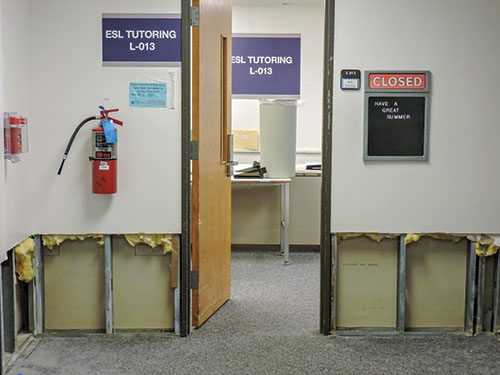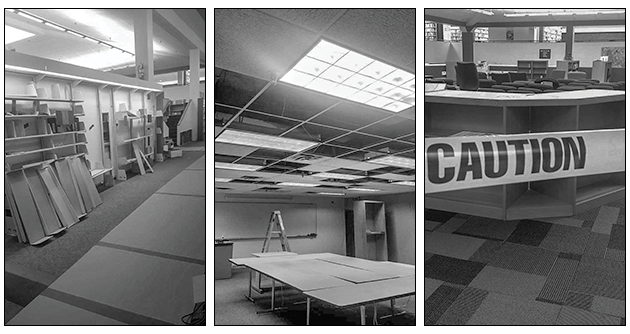
By Zoey Tincknell
The Scene staff
All of Missouri has been dealing with extreme weather lately, from a tornado in Jefferson City to severe thunderstorms and flooding along the Missouri and Meramec rivers.
The Forest Park campus has experienced its own water problems. On May 22, water surged in a pipe on the first floor of the library building, causing a sprinkler to burst and sounding a fire alarm.
Water soaked reference books, furniture, carpeting and walls on the main and lower levels of the library building and an adjacent basement area that housed the Academic Support Center, math classrooms, a teachers lounge and tutoring space for English as a second language.
Also damaged was expensive new medical training equipment destined for the new Center for Nursing and Health Sciences on campus.
“One single sprinkler has caused millions in damage,” said Julie Fickas, who recently became campus president and chief academic officer after serving a year as interim.
Damage to computers, printers and other technology is still being assessed. Most electrical fixtures, such as lighting, seem to be OK.
Officials don’t have final estimates on the cost of repairing facilities and replacing equipment, but they expect insurance to cover most of it.
Summer classes that had been scheduled in the basement area adjacent to the library building had to be moved, forcing administrators to find room for them elsewhere on campus and confusion for students who didn’t get notices until the last minute.
“My staff is amazing,” Fickas said. “They immediately took action and helped to move around as needed. I am grateful for each one of them.”
Officials predict the library will back to business as usual by August and that medical training equipment will be replaced in time for the Center for Nursing and Health Sciences to open in the fall, as planned.

Early morning emergency
Fire alarms sounded on campus late at night on May 22, which was a Wednesday. The fire department and Forest Park Facilities Manager Dennis Dill were already on the scene by the time Fickas arrived at 2:30 a.m. May 23.
“It took fire department officials three hours to walk around every room and every building to find the culprit of the fire alarms (the burst sprinkler) within the library,” Fickas said.
Three to four inches of standing water filled the lower level of the library building,which houses the Forest Park Archives and Bone Room. By 4 a.m., crews had arrived from companies that specialize in cleaning and restoration after fires, flooding and other catastrophes.
“Some reference books had to be thrown away, as the sprinkler was right above where they were kept,” said Reference Librarian Brian Cleveland. “Others are in the process of being saved through a company hired to freeze the wet books.”
Today, shelves on the main floor of the library are empty. The top floor is open to students who want to access books and other materials. Cardboard walkways show them where they can and can’t go.
The worst flooding damage occurred in the basement area adjacent to the library building, particularly in the Academic Support Center. Workers had to remove sections of walls to keep mold from growing.
Carpets are stained. Giant fans line the hallway. Furniture and computers are stacked in classrooms. A musty smell permeates the air.
“We were out for a couple of days,” said Kathy Boykan, administrative assistant in the Academic Support Center. “There was a lot of moving around from the D building to the Highlander Lounge and finally back underneath the library, where we are currently running and open to students.”
The center’s writing and math labs are open, and tutoring for English as a second language is available.
Medical training equipment for the Center for Nursing and Health Sciences had been stored in the lower level of the library building to keep it cool. Water damaged computerized mannequins, advanced nursing-wound kits and reference books.
“Water is a powerful thing,” said Karen Mayes, chairwoman of the St. Louis Community College nursing department. “It’s going to do what it wants to do. But to the best of my knowledge, we’re still opening (the center) on time.”
Bones and archives saved
Forest Park officials got some good news in the midst of the devastation. The contents of the Bone Room and Archives Room escaped damage.
The Bone Room contains anatomical models and other resources for anatomy and physiology students. They were all on shelves, tables or stands, off the floor where water flowed.
“The Bone Room is Mrs. Williams’ baby,” said tutor Suzanne Roussin, speaking of Librarian June Williams. “She knows I am passionate about it as well. We arrived to see nothing had been damaged, and I’m happy to say the Bone Room is up and running at full capacity.”
The Archives Room stores historical photographs and documents, many of them irreplaceable. It also was spared from water damage.
After the flooding, summer classes couldn’t be held in math classrooms in the basement area adjacent to the library building. They had to be relocated to other parts of campus.
That included a Basic Math class taught by associate professor Regina Covington. It was moved to the fourth floor of E Tower, next to The Scene student newspaper.
“I was a little bit overwhelmed because summer classes were beginning,” Covington said. “Students were frustrated by receiving an email of the changes the day before. They weren’t prepared for the relocation.”
